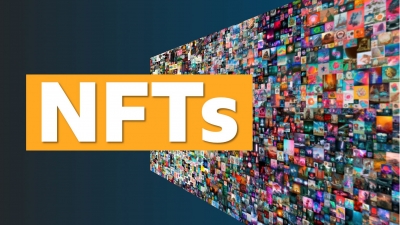
NFT stands for Non-fungible token. It is fuelled by blockchain technology, meaning it is a unit of digital data. What makes NFTS different from bitcoins is that they are non-fungible. An NFT is unique and cannot be replaced with something else. For example, a bitcoin could be traded for another bitcoin but you get the same thing – 10 bitcoins = 10 bitcoins or something worth 10 bitcoins. However, if you trade an NFT, you get something that is completely different – an NFT art piece = whatever rate is paid for it
NFTS can represent digital files such as audio, video, drawings/artwork, a piece of writing, items in a video game and any other forms of creative work. It can be used to commodify digital creations and fetch money for digital creators.
The first NFTs were based on the Ethereum open-source blockchain and appeared around 2015. More recently, NFTs have become hugely popular with collectors and speculators having spent over 200 million dollars on NFT-based artwork in February – March 2021. This, compared to 250 million dollars throughout 2020
How does it work?
Since NFTS are digital data, artists who wish to sell their works as NFTS need to register with an NFT marketplace and then mint digital tokens by uploading and validating their information on a blockchain. This can cost an artist anywhere between 40 and 200 dollars. After this, the artist can list his or her work for auction on an NFT marketplace, similar to Amazon or Ebay.
How is it different?
NFT artworks have been creating a lot of buzz recently, with many shelling out millions to buy pieces. This new trend has given hope to artists who have been uploading their works on sites such as Facebook and Instagram for free to gain exposure and visibility.
However, a piece of digital art can be uploaded or circulated by anyone on the Internet. So what is the benefit for a collector buying an NFT? While the artworks can be reproduced or circulated by anyone, NFT gives the buyer the ownership rights to the original artwork. Like physical art the artist can still retain the copyright and reproduction rights, but the person who has bought the NFT owns the original artwork.
In the limelight
NFT art has suddenly started to trend all over the world after a collector group purchased a digital artwork by artist Mike Winkelmann, known as Beeple for a record-breaking price of 69 million dollars at an auction by Christie’s on March 11, 2021.
The piece that fetched the price is titled “Everydays: The First 5000 Days”. It is a collage of Winkelmann’s sketches that he posted daily and traces the evolution of digital shapes and sceneries through till the beginning of this year.
Winkelmann’s work fetched the third highest price ever by any currently living artist, after Jeff Koons and David Hockney
Al artwork
Remember the humanoid Sophia, developed by Hanson Robotics? She has created artworks in collaboration with 31-year-old Italian digital artist Andrea Bonaceto. Sophia’s work, titled “Sophia Instantiation” is a 12-second MP4 file showing the evolution of Bonaceto’s portrait into Sophia’s digital painting. The MP4 file is accompanied by a physical artwork painted by Sophia on a printout of her self-portrait. Her work, which went for auction late last month, sold for nearly 700,000 dollars.
Beyond art
If you thought only NFT art was fetching money, you are mistaken. On Monday, March 22, Jack Dorsey, the co-founder of Twitter, sold his first-ever tweet on the platform as an NFT for 2.9 million dollars! The tweet, which reads, “just setting up my twttr”, was posted by Dorsey on March 21, 2006.
Picture Credit : Google




